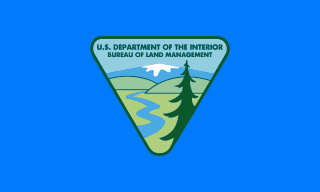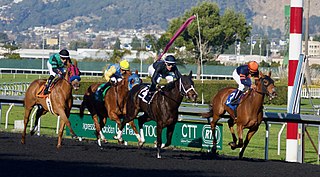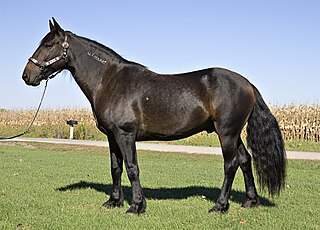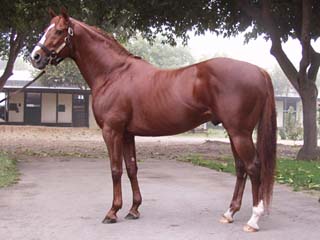
The Bureau of Land Management (BLM) is an agency within the United States Department of the Interior responsible for administering federal lands. Headquartered in Washington DC, and with oversight over 247.3 million acres (1,001,000 km2), it governs one eighth of the country's landmass.

Horse racing is an equestrian performance sport, typically involving two or more horses ridden by jockeys over a set distance for competition. It is one of the most ancient of all sports, as its basic premise – to identify which of two or more horses is the fastest over a set course or distance – has been mostly unchanged since at least classical antiquity.

A cowboy is an animal herder who tends cattle on ranches in North America, traditionally on horseback, and often performs a multitude of other ranch-related tasks. The historic American cowboy of the late 19th century arose from the vaquero traditions of northern Mexico and became a figure of special significance and legend. A subtype, called a wrangler, specifically tends the horses used to work cattle. In addition to ranch work, some cowboys work for or participate in rodeos. Cowgirls, first defined as such in the late 19th century, had a less-well documented historical role, but in the modern world work at identical tasks and have obtained considerable respect for their achievements. Cattle handlers in many other parts of the world, particularly South America and Australia, perform work similar to the cowboy.

The mustang is a free-roaming horse of the Western United States, descended from horses brought to the Americas by the Spanish. Mustangs are often referred to as wild horses, but because they are descended from once-domesticated animals, they are actually feral horses. The original mustangs were Colonial Spanish horses, but many other breeds and types of horses contributed to the modern mustang, now resulting in varying phenotypes. Some free-roaming horses are relatively unchanged from the original Spanish stock, most strongly represented in the most isolated populations.

The Percheron is a breed of draft horse that originated in the Huisne river valley in western France, part of the former Perche province from which the breed takes its name. Usually gray or black in color, Percherons are well muscled, and known for their intelligence and willingness to work. Although their exact origins are unknown, the ancestors of the breed were present in the valley by the 17th century. They were originally bred for use as war horses. Over time, they began to be used for pulling stagecoaches and later for agriculture and hauling heavy goods. In the late 18th and early 19th centuries, Arabian blood was added to the breed. Exports of Percherons from France rose exponentially in the late 19th century, and the first purely Percheron stud book was created in France in 1893.

A horse show is a judged exhibition of horses and ponies. Many different horse breeds and equestrian disciplines hold competitions worldwide, from local to the international levels. Most horse shows run from one to three days, sometimes longer for major, all-breed events or national and international championships in a given discipline or breed. Most shows consist of a series of different performances, called classes, wherein a group of horses with similar training or characteristics compete against one another for awards and, often, prize money.

The American Civil War saw extensive use of horse-mounted soldiers on both sides of the conflict. They were vital to both the Union Army and Confederate States Army for conducting reconnaissance missions to locate the enemy and determine their strength and movement, and for screening friendly units from being discovered by the enemy's reconnaissance efforts. Other missions carried out by cavalry included raiding behind enemy lines, escorting senior officers, and carrying messages.

A feral horse is a free-roaming horse of domesticated stock. As such, a feral horse is not a wild animal in the sense of an animal without domesticated ancestors. However, some populations of feral horses are managed as wildlife, and these horses often are popularly called "wild" horses. Feral horses are descended from domestic horses that strayed, escaped, or were deliberately released into the wild and remained to survive and reproduce there. Away from humans, over time, these animals' patterns of behavior revert to behavior more closely resembling that of wild horses. Some horses that live in a feral state but may be occasionally handled or managed by humans, particularly if privately owned, are referred to as "semi-feral".

English riding is a form of horse riding seen throughout the world. There are many variations, but all feature a flat English saddle without the deep seat, high cantle or saddle horn that are part of a Western saddle nor the knee pads seen on an Australian Stock Saddle. Saddles within the various English disciplines are all designed to allow the horse the freedom to move in the optimal manner for a given task, ranging from classical dressage to horse racing. English bridles also vary in style based on discipline, but most feature some type of cavesson noseband as well as closed reins, buckled together at the ends, that prevents them from dropping on the ground if a rider becomes unseated. Clothing for riders in competition is usually based on traditional needs from which a specific style of riding developed, but most standards require, as a minimum, boots; breeches or jodhpurs; a shirt with some form of tie or stock; a hat, cap, or equestrian helmet; and a jacket.

The Black Rock Range is a mountain range in northwestern Nevada. It is named for Black Rock Point, which is located at the southern end of the range. The Black Rock Range divides the Black Rock Desert into eastern and western arms. Pahute Peak, also known as Big Mountain, is the highest point in the range at 8,566 feet (2,611 m) above sea level.

An equestrian drill team is a group of horses and riders performing choreographed maneuvers to music. Teams typically perform at rodeos, horse fairs, parades, benefits, and drill team competitions. Drill teams are intended to entertain, show sportsmanship, horsemanship, teamwork and dedication. Competition drill at the national level is a controlled ride and has continuous forward motion. Some competition venues have set up special divisions of competition to provide for novice, rodeo, youth, gaited and special effects such as theme and drama. Theme drill provides a division that allows teams to showcase their uniforms, horse ability, music, and inclusions of trick riding or other variations.
An equestrian facility is created and maintained for the purpose of accommodating, training or competing equids, especially horses. Based on their use, they may be known as a barn, stables, or riding hall and may include commercial operations described by terms such as a boarding stable, livery yard, or livery stable. Larger facilities may be called equestrian centers and co-located with complementary services such as a riding school, farriers, vets, tack shops, or equipment repair.

The Sheldon National Wildlife Refuge is a 573,504-acre (232,089 ha) national wildlife refuge on the northern border of the U.S. state of Nevada. A very small part extends northward into Oregon. It is managed by the United States Fish and Wildlife Service (USFWS) as the Nevada component of the Sheldon-Hart Mountain National Wildlife Refuge Complex, which is headquartered in Lakeview, Oregon. The Sheldon Refuge was noted for its population of wild horses, now all removed.

The Thoroughbred is a horse breed developed for horse racing. Although the word thoroughbred is sometimes used to refer to any breed of purebred horse, it technically refers only to the Thoroughbred breed. Thoroughbreds are considered "hot-blooded" horses that are known for their agility, speed, and spirit.

The Mountain states form one of the nine geographic divisions of the United States that are officially recognized by the United States Census Bureau. It is a subregion of the Western United States.
The Pryor Mountains Wild Horse Range is a refuge for a historically significant herd of free-roaming mustangs, the Pryor Mountain mustang, feral horses colloquially called "wild horses", located in the Pryor Mountains of Montana and Wyoming in the United States. The range has an area of 39,650 acres (160.5 km2) and was established in 1968 along the Montana–Wyoming border as the first protected refuge dedicated exclusively for mustangs. It was the second feral horse refuge in the United States. About a quarter of the refuge lies within the Bighorn Canyon National Recreation Area. A group of federal agencies, led by the Bureau of Land Management, administers the range.

The Wild and Free-Roaming Horses and Burros Act of 1971 (WFRHBA), is an Act of Congress, signed into law by President Richard M. Nixon on December 18, 1971. The act covered the management, protection and study of "unbranded and unclaimed horses and burros on public lands in the United States."

The Pryor Mountain mustang is a substrain of mustang considered to be genetically unique and one of the few strains of horses verified by DNA analysis to be descended from the original Colonial Spanish horses brought to the Americas by the Spanish. They live on the Pryor Mountains Wild Horse Range located in the Pryor Mountains of Montana and Wyoming in the United States, and are the only mustang herd remaining in Montana, and one of sixteen in Wyoming. They are protected by the Wild and Free-Roaming Horses and Burros Act of 1971 (WFRHBA) and managed by the Bureau of Land Management (BLM), who has set the optimum herd number at 120 animals. Genetic studies have revealed that the herd exhibits a high degree of genetic diversity and a low degree of inbreeding, and BLM has acknowledged the genetic uniqueness of the herd. Pryor Mountain Mustangs are relatively small horses, exhibit a natural ambling gait, and domesticated Pryor Mountain mustangs are known for their strength, sure-footedness and stamina. The Pryor Mountains Wild Horse Range is one of the most accessible areas to view feral horse herds in the United States and tourism to the area has increased in recent years.
Horse Mountain is a prominent mountain summit in the San Juan Mountains range of the Rocky Mountains of North America. The 9,952-foot (3,033 m) peak is located in San Juan National Forest, 15.8 miles (25.5 km) west by north of the Town of Pagosa Springs in Archuleta County, Colorado, United States.

A Marine Detachment, or MarDet, was a unit of 35 to 85 United States Marines aboard large warships including cruisers, battleships, and aircraft carriers. They were a regular component of a ship's company from the formation of the United States Marine Corps until 1998. Missions of the Marine Detachment evolved, and included protecting the ship's captain, security and defense of the ship, operating the brig, limited action ashore, securing nuclear weapons and ceremonial details.

















